- home
- BAKERECIPES
BakeRecipes
Bringing real baking into your home with deliciously simple recipes.
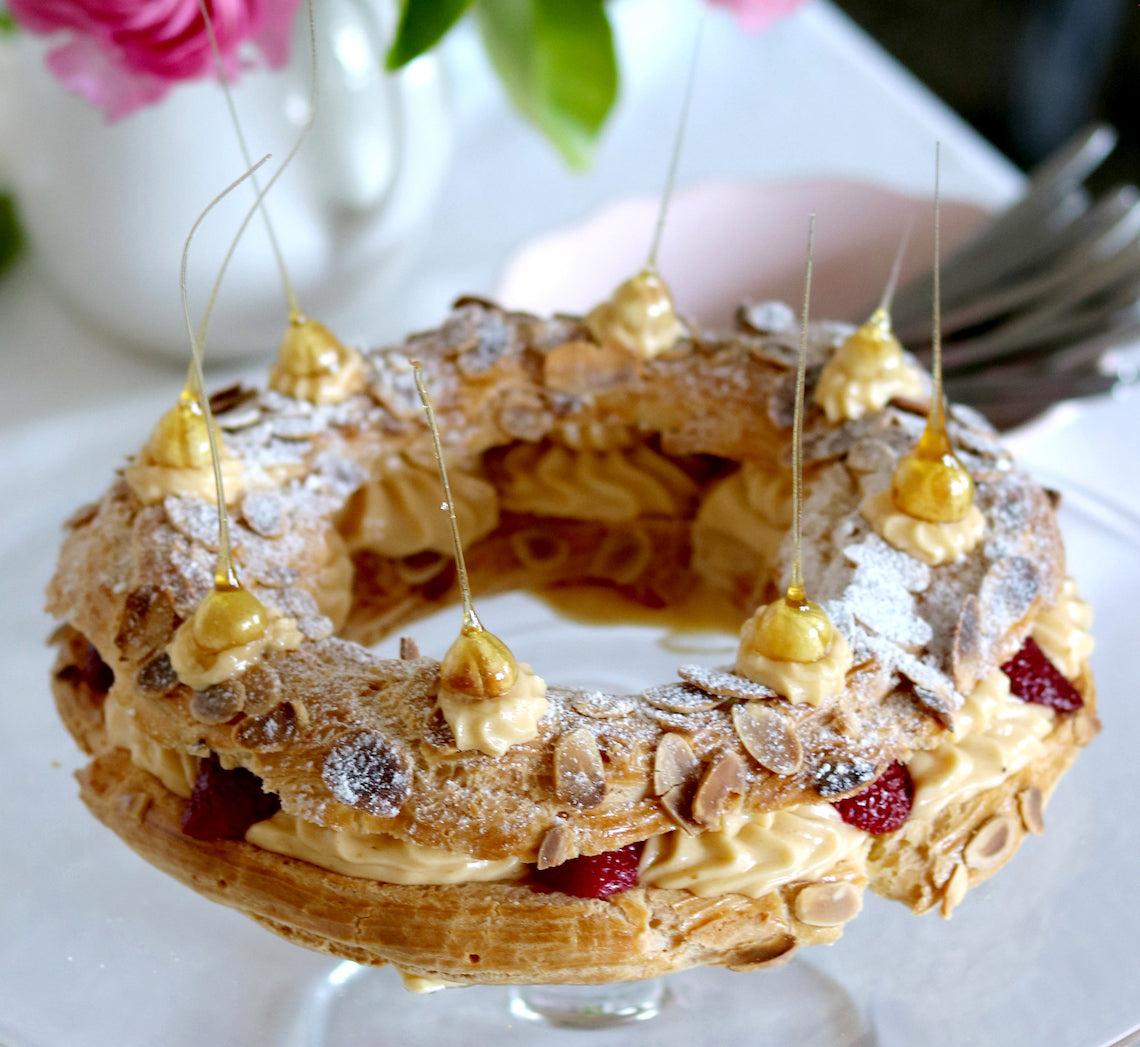
Prep 2hrBake 40-45minMakes 12-15 serves
Created by Make Me a Baker student Janine Cowen for her Graduation, this classic dessert has been elevated by the addition of a divine hazelnut praline crème mousseline filling and roasted rosewater strawberries.
"I picked the recipe because it is something I have always wanted to taste and try to bake, but I've never had the confidence to tackle such a complex recipe or even the know-how to make choux pastry. Reading all of the elements was overwhelming at first, but being able to calmly break it down and methodically follow the steps to produce the final dessert was so satisfying. It has opened up a whole world of challenging multi-element recipes for me to try," says Janine
Janine also suggests, when in season, roasting quartered fresh figs with a little brown sugar to replace the strawberries.
Ingredients
1 quantity Basic Choux Pastry
1 egg yolk, whisked with a dash of water, to brush
30g flaked almonds
Icing sugar, to dust
Crème Pâtissière (original recipe from Mastering the Art of Baking by Anneka Manning, Murdoch Books)
1 vanilla bean, split lengthways and seeds scraped
250ml (1 cup) full-cream milk
250g (1 cup) pure (thin/pouring) cream
4 egg yolks
150g caster sugar
2 tablespoons plain flour
1 tablespoon cornflour
Crème Mousseline
225g unsalted butter, softened
Praline Paste (Janine used a recipe from Serious Eats by Kristina Razon)
Toffeed Hazelnuts (based on a recipe from The Pastry School cookbook by Julie Jones)
20 whole hazelnuts
220g (1 cup) caster sugar
100ml water
Roasted Strawberries
400g ripe but firm larger strawberries, hulled and halved
2 teaspoons caster sugar
4 drops rosewater essence
Small pinch fine salt
Method
-
To make the Crème Pâtissière, combine the vanilla seeds, milk and cream in a medium saucepan and bring just to a simmer over a medium heat. Remove from heat. Use a balloon whisk or electric mixer with a whisk attachment to whisk the egg yolks and sugar together in a heatproof bowl until thick and pale. Sift together the flour and cornflour, then whisk into the yolk mixture until smooth and well combined. Gradually whisk in the milk mixture until smooth and well combined. Return to the saucepan. Stir constantly with a balloon whisk over a medium heat until the mixture comes to a simmer. Simmer, stirring constantly with the whisk, for 2 minutes. Remove from heat and pass the crème pâtissière through a sieve into a heatproof bowl. Cover the surface of the crème pâtissière with plastic wrap or a round of baking paper and refrigerate for 2 hours or until well chilled before using.
-
To make the Toffeed Hazelnuts, gently insert a toothpick into the base of each hazelnut (being careful not to split them). Cover a benchtop under a cupboard or shelf with foil to catch the dripping caramel. Place a strip of double-sided sticky tape or Blu Tack on the bottom edge of a cupboard or shelf (this will hold the hazelnuts by the toothpicks). Fill your kitchen sink or a large bowl with about 3cm of water. Combine the caster sugar and water in a small saucepan and use a wooden spoon to stir over low heat until the sugar dissolves. Increase the heat to medium and bring to the boil. Boil, occasionally brushing down the side of the pan with a pastry brush dipped in water to dissolve any sugar crystals, until the mixture turns a deep caramel. Remove immediately from the heat and place the saucepan base in the water until the bubble subside to stop it from cooking. Remove the saucepan from the water and set aside for 1-2 minutes near the lined bench or until the caramel thickens enough to coat the hazelnuts. One at a time and holding the toothpick, carefully dip the hazelnuts into the caramel and then stick the toothpick to the cupboard or shelf using the sticky tape or Blue Tack so that the caramel drips onto the foil and a tail forms. It may take a few hazelnuts before the caramel has thickened enough for a good tail to form. Let the caramel set (it will take about 10-15 minutes) before gently removing the toothpicks from the hazelnuts. Place in an airtight container separated by baking paper.
-
To make the Roasted Strawberries, preheat the oven to 200°C (180°C fan-forced) and line an oven tray with non-stick baking paper. Place the strawberries in a large bowl and sprinkle with the caster sugar, rosewater essence and salt. Toss gently to coat evenly and then spread the strawberries, cut side down, evenly on the lined tray. Roast in preheated oven for 10 minutes or until starting to soften but still holding their shape. Place in an airtight container in the fridge until required (see Baker’s Tips).
-
To make the choux pastry ring, draw a 12cm diameter circle on a piece of non-stick baking paper. Turn the paper upside down, line a baking tray with it, and use a little of the choux pastry to stick the baking paper to the tray. Preheat the oven to 200°C (180°C fan-forced).
-
Spoon the choux pastry into a large piping bag fitted with a 13mm (6B) French star piping nozzle. Using the marked paper as a guide, pipe a ring of choux pastry onto the lined tray. Pipe another ring of pastry around the outside of the first one, so that they just touch. Finally pipe a third circle of pastry over the gap between the two bottom pastry rings. Bruch the rings gently with the egg wash and then sprinkle with the flaked almonds. Bake in preheated oven for 35 minutes. Reduce the oven temperature and bake for a further 25 minutes or until the pastry is puffed, golden and dry.
-
Immediately transfer the pastry ring to a wire rack and use a skewer to piece the ring on top about 8 times (this will allow the excess steam trapped inside to escape while it cools). See Baker’s Tips.
-
Meanwhile, to make the Crème Mousseline, use an electric mixer with a paddle beater to beat the butter until very pale and creamy, scraping down the side of the bowl when necessary. Add the Praline Paste and beat on medium speed until well combined. Gradually add the Crème Pâtissière, about ¼ cup at a time, and beat on medium speed after each addition until well combined, scraping the bowl when necessary. Replace the paddle beater with the whisk attachment and whisk on medium speed for about 3 minutes or until the mousseline is light and airy. Transfer about three quarters of the Crème Mousseline to a piping bag fitted with a 15mm French star piping nozzle (see Baker’s Tips).
-
Use a large sharp serrated knife to carefully cut the pastry ring in half horizontally. Remove any uncooked dough with your fingertips. Set the top aside. Pipe rosettes of the Crème Mousseline into the base of the pastry ring about 2cm apart. Then pipe another, slightly smaller, rosette on top of each Place a strawberry half, cut side down, between each of the Crème Mousseline rosettes, placing them so they overlap the edge of the pastry ring base and peek out once the lid is placed on top. Gently place the pastry ring lid on top and then dust with icing sugar.
-
Place the remaining Crème Mousseline in a piping bag fitted with a 5mm French star piping nozzle and pipe eight small rosette at even intervals on the top of the pastry ring. Choose the best eight Toffeed Hazelnuts and carefully place one on top of each of the piped rosettes to decorate. Serve immediately.
Baker's Tips
- The Crème Pâtissière can be made up to 3 days before using. Place in an airtight container or a bowl and cover the surface with plastic wrap and keep in the fridge.
- The Roasted Strawberries can be made up to 3 days before using. Place in an airtight container in the fridge.
- The pastry ring can be made up to a day ahead. Keep in an airtight container at room temperature. To refresh before filling, place on a lined oven tray in an oven preheated to 180°C (160°C fan-forced) for 10 minutes. Allow to cool before using.
- In warmer weather, the Crème Mousseline may become a little soft. If so, before piping place it into the fridge until it firms enough to be a good piping consistency before continuing with the recipe.

Prep 20minBake 15-25 minMakes about 12 large cookies
This great basic cookie recipe (requiring only a bowl and a wooden spoon to mix) can be customised depending on your flavour and texture preferences… Choose from the suggested ingredients to add your twist and to personalise the cookies – the variation options are only limited by your imagination (and a little baking science)!
Ingredients
Base
125g salted butter, melted
110g (½ cup) caster sugar
110g (½ cup, firmly packed) brown sugar
1 egg
185g-225g plain flour (see Baker's Tips)
½ teaspoon bicarbonate of soda
Ingredients for flavour (choose at least 1)
1-2 teaspoons vanilla essence or extract or vanilla bean paste
½ teaspoon ground cinnamon
1 orange, lemon or lime, zest finely grated
Sea salt flakes, to taste
Ingredients for texture (choose at least 1)
100g chocolate (dark, milk, white or a combination) – 150g if not using nuts also
100g toasted nuts (macadamias, pecans, salted peanuts, peeled hazelnuts, almonds, walnuts or pistachios), coarsely chopped
150g Smarties or M&M's
100g soft caramels, chopped
1 cup shredded or flaked coconut
Method
- Preheat oven to 180°C (160°C fan-forced). Line a large oven tray with non-stick baking paper.
- Combine the butter, caster sugar and brown sugar in a medium bowl and beat with a wooden spoon until smooth and well combined. Add the egg (and vanilla and/or citrus zest if using) and beat with the wooden spoon until the mixture becomes pale, creamy and thickens slightly (this will take 1-2 minutes).
- Sift together the flour (see Baker’s Tips) and bicarbonate of soda (and cinnamon if using). Add to the butter mixture and stir until well combined. Add the chocolate, nuts, Smarties, M&M's and/or caramels and stir to combine evenly.
- Roll 2 level tablespoonfuls (see Baker's Tips) of the cookie dough into balls and place on the lined oven tray about 10cm apart (see Baker's Tips).
- Bake in preheated oven for 5 minutes. Lift the baking tray on one side and let it fall back onto the oven rack 3 times (see Baker’s Tips). Sprinkle with coconut or finely chopped nuts if using. Bake for 5 minutes longer then lift the baking tray on one side and let it fall back onto the oven rack 3 times again. Bake for a further 5-15 minutes (see Baker’s Tips).
- Cool the cookies on the trays for 5 minutes or until firm enough to transfer to a wire rack to cool completely. Repeat with the remaining cookie dough.
Baker's Tips
- Using less flour (185g) will mean that your cookies will spread more and be thinner than if you use more flour (225g).
- To bake smaller cookies, roll 1 tablespoon measure of dough into balls and place on the oven trays at least 7cm apart. Bake as per recipe.
- You can use a small ice-cream scoop to scoop your cookie dough and place it straight onto the oven trays but you will find the cookies will be more evenly shaped if rolled before baking.
- Chilling the balls of dough for 30 minutes before baking will give your cookies more contrast in texture between the centre and the outer edge.
- Banging the trays on the oven racks during baking will give the cookies a ‘crinkled’ appearance once baked and will also be thinner than those that aren’t.
- You can determine the texture of these cookies by adjusting the baking time. 15 minutes will give you a cookie with a soft, chewy centre and crisp outer; 20 minutes will give you a slightly soft centre and crisp outer; while 25 minutes will mean the cookies are crisp all the way through.
- These cookies will keep in an airtight container at room temperature for up to 1 week.
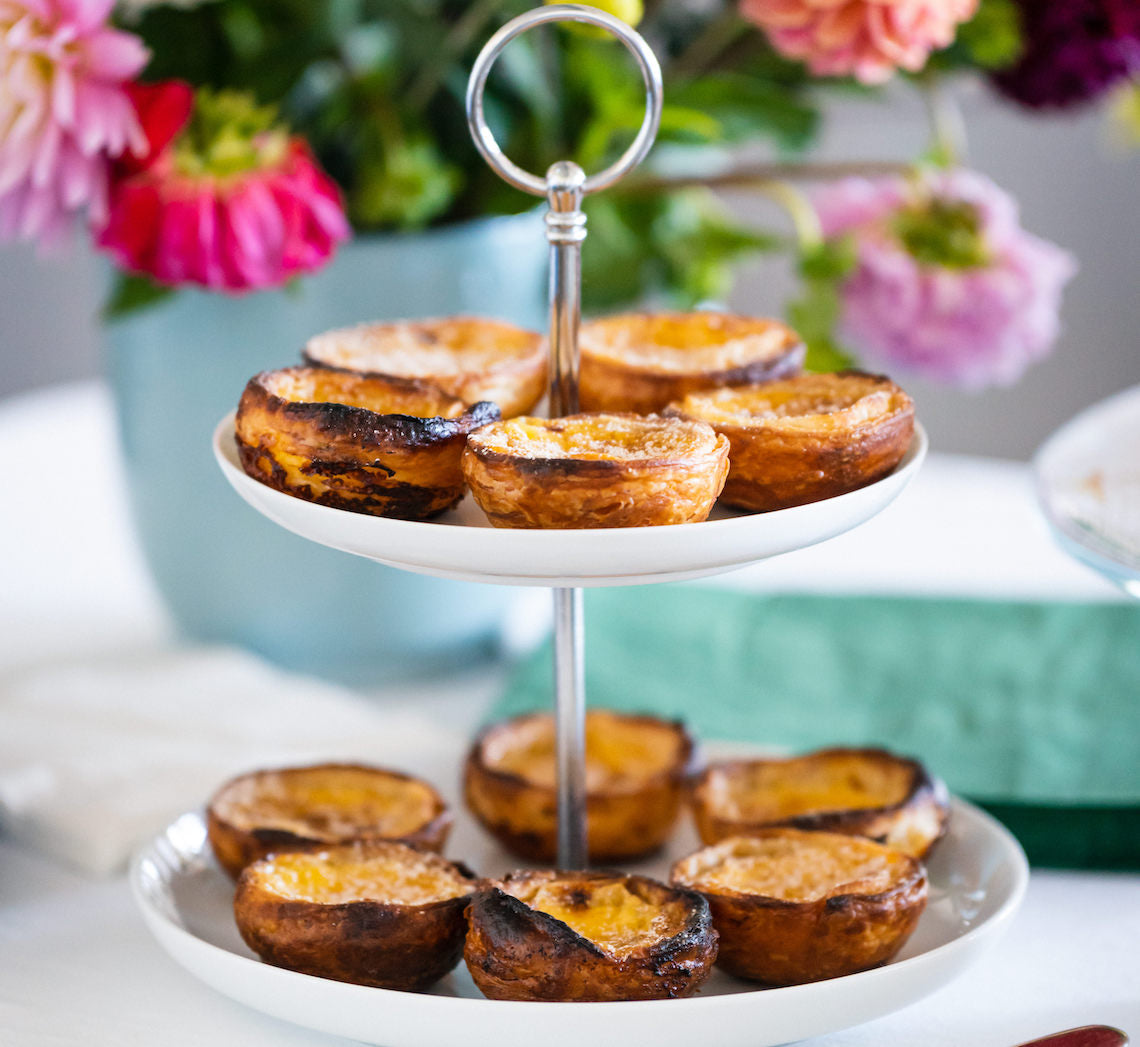
Prep 1hr (+20min resting, 2hr chilling and 30min cooling time)Bake 12-15min (per batch)Makes 24
Made by Make Me a Baker student Theresa Ling these Portuguese Custard Tarts will be some of the best you will try. The main trick with these tarts is to bake them at a very high heat (often as hot as your oven will go) for a short period of time to make sure the pastry is lovely and crisp while not over cooking the luscious creamy custard filling, creating a wonderful contrast between the two.
If you've never made portuguese custard tarts before or haven't got the results you wanted from a previous attempt CLICK HERE for my top tips when making them
at home before you start.
Ingredients
Icing sugar and ground cinnamon (optional), to sprinkle
Rough Puff Pastry
225g (1½ cups) plain flour
½ teaspoon salt
140g water
225g unsalted butter, softened
Custard
2 tablespoons plain flour300ml milk
220g (1 cup) caster sugar
160ml (⅔ cup) water
2 cinnamon sticks
½ teaspoon natural vanilla essence or extract
6 egg yolks, lightly whisked
Method
-
To make the Rough Puff Pastry, place the flour and salt in the bowl of a stand mixer. Add the water and mix with a paddle beater on low speed until well combined and a dough forms. Transfer the dough to a clean bench top and knead until smooth. Shape into a square about 1cm thick, wrap in plastic wrap and set aside to rest for 20 minutes.
- Use a lightly floured rolling pin to roll the pastry out on a well floured surface to a 35cm square, keeping the edges as neat as possible. Use your fingers to dot small pieces of 75g of the softened butter over the left two-thirds of the pastry, leaving about a 1cm border, and then spread it with your fingers so it covers the pastry roughly. Fold over the unbuttered right hand third of pastry, brush away any excess flour, then fold over the left hand third to cover. Starting from the top, use the rolling pin to tap the pastry widthways to release any air pockets and then press the open edges with your fingertips to seal and enclose the butter. Turn the pastry a quarter turn anticlockwise and then fold in the right hand third of pastry then fold over the left hand third to cover. Again, tap it gently widthways with the rolling pin.
- Reroll the pastry to a 35cm square and, with the folded edge closest to you repeat step 2 one more time, dotting and spreading the left hand two thirds with 75g of the remaining softened butter, folding, turning anti-clockwise and folding again.
- Reroll the pastry to a 35cm x 40cm rectangle. With a short edge closest to you, dot and spread the 75g of remaining softened butter over the whole surface, leaving a 1cm border. Starting from the short edge, roll into a tight log. Use a sharp knife to trim the ends and then cut the log in half. Wrap the logs separately in plastic wrap and place in the fridge to chill for at least 2 hours before using (see Baker’s Tips).
- Place two pizza stones in the oven, one in the top third and one in the bottom third. Place an oven rack in between them. Preheat oven to 300°C (280°C fan-forced) for at least 1 hour.
- To make the Custard, place the flour in a medium bowl and use a balloon whisk to gradually stir in 60ml (¼ cup) of the milk until smooth and well combined. Place the remaining milk in a small saucepan and bring just to a simmer over a medium heat. Use the balloon whisk to gradually stir the hot milk into the flour mixture and stir until smooth and well combined. Combine the sugar, water and cinnamon sticks in a medium saucepan and stir over medium heat until the sugar dissolves. Bring to the boil and simmer until it reaches 100°C on a thermometer. Remove the cinnamon sticks from the sugar syrup and gradually stir into the milk mixture. Add the vanilla and stir until cooled slightly. Stir in the egg yolks until evenly combined. Cover the surface of the custard with plastic wrap and place in the fridge to cool, stirring occasionally, this will take about 30 minutes (see Baker’s Tips).
- Cut one of the pastry logs into twelve 1.5cm lengths (each portion will be about 25g) and place each portion, with a cut side facing up, into an ungreased 50ml capacity (3cm base measurement and 6.5cm top measurement) round-based tartlet tin (see Baker’s Tips). Using your thumb, gently press into the centre of a pastry portion towards the base until about 5mm thick, and then, using your thumbs and working around the tart case, gently ease the pastry up the sides thinning it to about 5mm thick and so it extends about 2mm above the tart tin and forms a thicker lip at the top. Repeat with the remaining pastry portions.
- Place the tart tins on a heavy oven tray. Divide half the cooled custard among the pastry cases, filling each to no more than 5mm from the top edge of the pastry. Bake the tarts between the pizza stones in the preheated oven for 12-15 minutes or until the pastry is crisp and baked through, and the custard is just set and partially charred on the top.
- Remove the tarts from the oven and set aside to cool slightly for 2-3 minutes before removing from the tins. Repeat with the remaining pastry log and custard mixture to make 12 more tarts.
- Sprinkle the tarts with icing sugar and/or cinnamon if desired and serve warm or at room temperature (see Baker’s Tips).
Baker's Tips
- The pastry can be made up to 3 days ahead of using. Keep wrapped in the fridge.
- The custard can be made up to 3 days ahead of baking. Store in an airtight container or jar in the fridge. Stir well before pouring into the tart cases.
- Once cut into portions and before pressing into the tins, you may have to let the pastry stand at room temperature until it softens slightly and becomes pliable enough to be able to be pressed into the tins easily and without force.
- These tarts are best eaten warm or at room temperature the day they are made. However, they will keep in an airtight container in the fridge for up to 2 days. To refresh, place the chilled tarts back in the tart tins on an oven tray and place in an oven preheated to 180°C (160°C fan-forced) for 10 minutes or until the pastry is crisp and the custard is just warmed through (there is no need to use the pizza stones when reheating). Stand the tarts in the tins for at least 5 minutes before removing and serving warm or at room temperature.
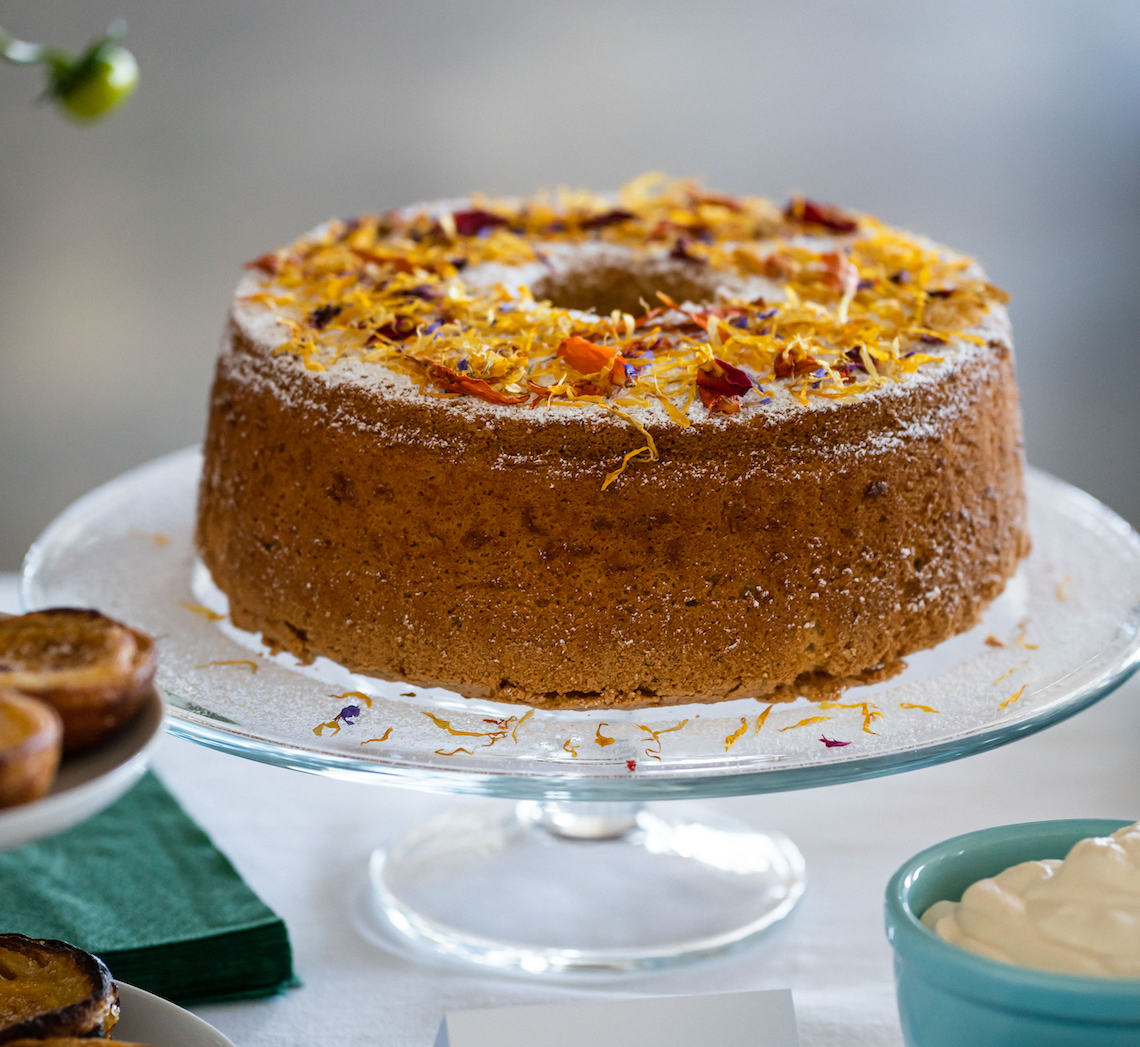
Prep 30min (+2hr cooling and overnight chilling time)Bake 45-50minMakes 8-10 serves
Created by Make Me a Baker student Jenny Wong for her graduation, this gorgeous cake is 'tea time' in a cake bringing together orange-scented chiffon cake and the subtle floral notes of French Earl Grey tea. And to make it complete, it's served with an Earl Grey tea-infused whipped cream and, of course a cup of freshly brewed French Earl Grey tea.
You will need a 21cm (base measurement) specialty angel food cake tin (basically a deep ring tin with a removable base and small 'feet' around the top rim) to make this recipe and they are available from specialty kitchenware stores. The key to achieving the classic feather-like texture of a chiffon cake is to make sure you leave it suspended in the inverted tin until cooled completely so that it doesn’t compress as it cools.
Ingredients
- 6 x T2 French Earl Grey tea bags
- 160ml ( ⅔ cup) boiling water
- 185g (1¼ cups) self-raising flour
- 30g (¼ cup) cornflour
- 1 teaspoon cream of tartar
- ½ teaspoon salt
- 6 x 59g eggs, at room temperature, separated
- 200g caster sugar, plus 110g (½ cup) extra
- 2 teaspoons finely grated orange zest
- 1 teaspoon natural vanilla essence or extract
- 100ml vegetable oil
- Icing sugar, to dust
- Dried edible flowers, to decorate (optional) (see Baker's Tips)
Earl Grey Whipped Cream
- 125ml (½ cup) full-cream milk
- 4 x T2 French Earl Grey tea bags
- 300ml thickened cream
- 1 ½ teaspoons finely grated orange zest
- 1 ½ teaspoons natural vanilla essence or extract
Method
- To make the Earl Grey Whipped Cream, place the milk and tea bags in a small saucepan and heat over medium heat until hot but not boiling. Remove form the heat and allow to cool. Transfer to a container or bowl, cover and place in the fridge to chill (preferably overnight).
- Preheat oven to 180°C (160°C fan-forced). Place an ungreased 21cm (base measurement) angel food cake tin on an oven tray.
- Place the tea bags in a jug, pour the boiling water over and set aside to infuse until the water is warm.
- Sift the flour, cornflour, cream of tartar and salt onto a piece of baking paper twice.
- Use an electric mixer with a whisk attachment to whisk the egg yolks and 200g caster sugar on high speed until thick and pale. Whisk in the orange zest and vanilla.
- Squeeze the tea bags to extract as much flavour as possible into the warm tea-infused water and measure 125ml ( ½ cup) - it should be dark in colour and very fragrant.
- Combine the warm tea and oil. Add the oil mixture to the egg mixture and whisk on low speed until well combined, scraping the side and the base of the bowl if necessary. With the motor running on low speed, add the flour mixture all at once and whisk gently until just combined. Transfer the mixture to a separate large bowl and set aside. Clean and dry the whisk and mixing bowl.
- Use the electric mixer with the whisk attachment to whisk the egg whites on medium-high speed until soft peaks form. Add the remaining 110g caster sugar and whisk until thick and glossy and the sugar has dissolved. Add about a third of the egg whites to the yolk mixture and use a large metal spoon or spatula to fold through until well combined. Add the remaining egg white mixture and fold until just combined.
- Spoon the mixture into the ungreased tin and gently smooth the surface with the back of a metal spoon. Bake in the lower third of the preheated oven for 45-50 minutes or until well risen, golden, and a skewer inserted into the cake comes out clean.
- Immediately turn the cake upside down on a wire rack and set aside, still in the tin so it is suspended, for 2 hours or until it is completely cool – don’t be tempted to remove it while still warm (see Baker's Tips).
- To finish the Earl Grey Whipped Cream, squeeze the tea bags to extract as much flavour as possible and then measure 60ml (1/4 cup) of the milk – it should be a pale Masala Chai colour and very fragrant. Use a balloon whisk the cream in a medium bowl until soft peaks form. Add the orange zest and vanilla and then whisk in the chilled Earl Grey-infused milk until soft peaks form again. Cover and chill until serving.
- Carefully run a small palette knife around the side of the tin to release the cake. Invert the cake onto a serving plate or cake stand, and gently shake the tin to release the cake. Then use the palette knife to release the cake from the base of the tin and remove (see Baker's Tips). Serve dusted liberally with icing sugar and edible flowers (if using), and accompanied by the Earl Grey Whipped Cream.
Baker's Tips
- The key to the classic light-as-air texture of a chiffon cake is to suspend the baked cake in an inverted tin until it cools completely so that the crumb texture doesn’t compress as it cools. That is why it is so important that the tin isn't greased or lined so that the cake sticks to the tin and that it doesn't fall out of the tin during cooling. However, because of this, once cooled you will need to carefully release it by running a small palette knife between the cake and the tin. You won’t get a perfect looking crust, but this will be overlooked as the result will be a beautifully airy crumb texture that can’t be achieved without using this technique.
- This cake is best cut with a sharp knife using a sawing action.
- This cake will keep for up to 2 days in an airtight container at room temperature but is best eaten on the day it is made.
- Jenny used sun-dried organic edible flowers from Percaya Farm

Prep 30min (+2hr chilling and decorating time)Bake 20-25minMakes about 25 cookies
Use this recipe as the base for cookies decorated with either royal icing (like these gorgeous Iced Heart Cookies) or fondant. The sweetness of the icing complements the spicy gingerbread base perfectly and lays down a canvas for you to create something extra special for customers, friends and family.
Ingredients
125g salted butter, softened
90g (½ cup, lightly packed) brown sugar
235g (160ml/⅔ cup) golden syrup
1 teaspoon natural vanilla extract or essence
375g (2½ cups) plain flour
2 teaspoons ground ginger
1 teaspoon ground cinnamon
1 teaspoon bicarbonate of soda
Method
- Use an electric mixer with a paddle beater attachment to beat the butter and sugar on medium speed for 2-3 minutes, or until pale and creamy. Add the golden syrup and vanilla and beat to combine evenly. Sift together the flour, ginger, cinnamon and bicarbonate of soda. Add to the butter mixture and beat on low speed until just combined evenly and a soft dough forms. Turn the dough onto a lightly floured surface and divide into 2 equal portions. Shape each portion into a disc about 2cm thick, wrap in plastic wrap and place in the fridge for 2 hours or until firm enough to roll easily.
- Preheat the oven to 160°C (140°C fan-forced). Line two large oven trays with baking paper.
- Use a lightly floured rolling pin to roll out one portion of the dough (leave the remaining portion in the fridge) on a lightly floured benchtop to 6mm thick. Use cutter/s of your choice, approximately 7.5cm across at the widest part, to cut out shapes and then use a palette knife to carefully transfer the shapes to the prepared oven trays, leaving a little room between each for
spreading. Reroll any dough scraps to make more shapes. Discard any offcuts from the second rolling. Repeat with the remaining gingerbread dough portion. - Bake in preheated oven for 20-25 minutes, swapping the trays halfway through baking, or until the cookies are just starting to colour and are cooked through. Stand the cookies on the trays for a few minutes before transferring to a wire rack to cool completely. Decorate as desired.
Baker's Tips
- Undecorated biscuits will keep in an airtight container at room temperature for up to 5 days.

Prep 1-2hr (+drying time)Makes about 25 biscuits
If you're keen to show your loved one/s just how much they mean to you by baking them something irresistibly sweet, then you really can't go past a batch of these gorgeous cookies! The style of decorating used to create them is called 'flood on flood' icing and is a really effective way to decorate gingerbread or sugar biscuits. The key is to be patient, try not to rush and remember your designs will improve with practice. You will need at least three small piping bags and three Wilton or Loyal #4 round piping nozzles for this style. This Royal Icing recipe makes about 3 cups of icing and is enough to decorate about 25 average-sized cookies.
Ingredients
Gel food colours of your choice (we have used shades of 'rose pink' and 'raspberry'), to tint
About 25 gingerbread cookies
Edible sprinkles, to decorate
Royal Icing
3 egg whites (from 59g eggs) or 90g pasteurized egg whites (see Baker’s Tips)
675g (1½ cups) pure icing sugar, sifted through a fine sifter
½-3 teaspoons strained fresh lemon juice
Room temperature water, to thin icing
Method
- To make the Royal Icing, place the egg whites then the icing sugar in the bowl of an electric mixer. Use the paddle beater to beat on low speed until combined. Increase speed to medium and beat for 5 minutes. The icing will be smooth and thick at this stage. Add the lemon juice, ¼ teaspoon at a time, beating well between each addition, until the icing reaches a good piping consistency. The icing should be the consistency of toothpaste - soft but will hold its shape and form a soft peak when the beater is lifted.
- Immediately cover the bowl with plastic wrap and then a damp tea towel or cloth to prevent it from drying out (see Baker’s Tips).
- Divide the icing evenly between 3-5 small bowls (depending on how many different coloured icings you would like to use - we used 4 for these cookies including the white) and cover each bowl well. Transfer one white icing portion to a small piping bag fitted with a Wilton or Loyal #4 round piping tip (this will be used to pipe the outlines). Working with one portion of the remaining icing at a time, tint to desired colours, then add a little water, a drop at a time, and use a small palette knife or metal spoon to stir until it reaches the right consistency for ‘flooding’ (see Baker’s Tips). As soon as each portion reaches the right consistency, spoon into a small piping bag fitted with a Wilton or Loyal #4 round piping tip. Twist the end of the piping bag and seal with a clip or elastic band (this will help prevent it from drying out). Cover the tip with plastic wrap and then a damp cloth or tea towel and set aside while tinting and thinning the remaining icing portions.
- Use the white icing to pipe an outline around the inside edge of a cookie to create a border so that the icing in the centre won’t flow over the edge. Set aside for 3-5 minutes or until firm but not set.
- Pipe a tinted icing into the centre of a cookie to 'flood' it (making sure there will be enough to cover it comfortably but not too much so that the icing flows over the piped border). Use a toothpick to carefully spread the icing to cover fully, if needed, and then let the icing settle and become smooth. To achieve a ‘flood on flood’ effect (so that the pattern sinks into the base icing), while the icing is still wet, use contrasting tinted icing/s to pipe the stripes, dots or patterns onto the flooded icing (see Baker’s Tips). We created the heart pattern by piping dots and then dragging a toothpick through the dot from top to bottom and a little beyond. Sprinkle with edible sprinkles to decorate, if desired.
- Set iced cookies aside to dry completely overnight before storing (see Baker’s Tips).
Baker's Tips
- If you are concerned that these cookies will be served to pregnant women or people with compromised immune systems, use pasteurised egg whites. They are available in a carton from the refrigerated section of the supermarket.
- Royal Icing will dry out and start to set very quickly if not covered well. Cover bowls and the tips of filled icing bags with plastic wrap and then a damp tea towel while you are not using them to prevent the icing from drying out.
- To test if the icing is at the right consistency for ‘flooding’, drop a teaspoonful of the icing back into the bowl. If it melts back into the icing and the surface becomes flat in 5-6 seconds it is ready. If not, add a little more water to thin or a little more icing sugar to thicken it.
- If using the ‘flood on flood’ technique, to prevent the icing from spilling over the piped border, it is important not to over-flood the centre of the cookie with icing.
- It is best to have all the tinted icing consistencies the same for the best results for the 'flood on flood' technique. However, if two icing portions are slightly different consistencies, use the thinner one first to cover the cookie first and then use the slightly thicker one on top to create the decoration.
- If your royal icing becomes too thick during decorating, remove it from the piping bag and stir in a drop or two of water or enough to reach the desired consistency. A dropper is ideal for adding this small amount of water.
- The time it will take for the icing to dry/set will depend greatly on the weather (temperature and humidity). If humid, to assist in the drying, place the cookies on a lined tray in an oven preheated to 50°C for 30-60 minutes. Also if it is really humid, it is best to put the cookies straight into an airtight container lined with absorbent paper as soon as they cool from drying in the oven.
- These decorated cookies will keep in a single layer in a sealed airtight container lined with paper towel for up to 5 days.
- The Royal Icing will keep in a well-sealed container in the fridge for up to 3 days. Bring to room temperature to use. You may need to add a little more water to bring it to the correct consistency.
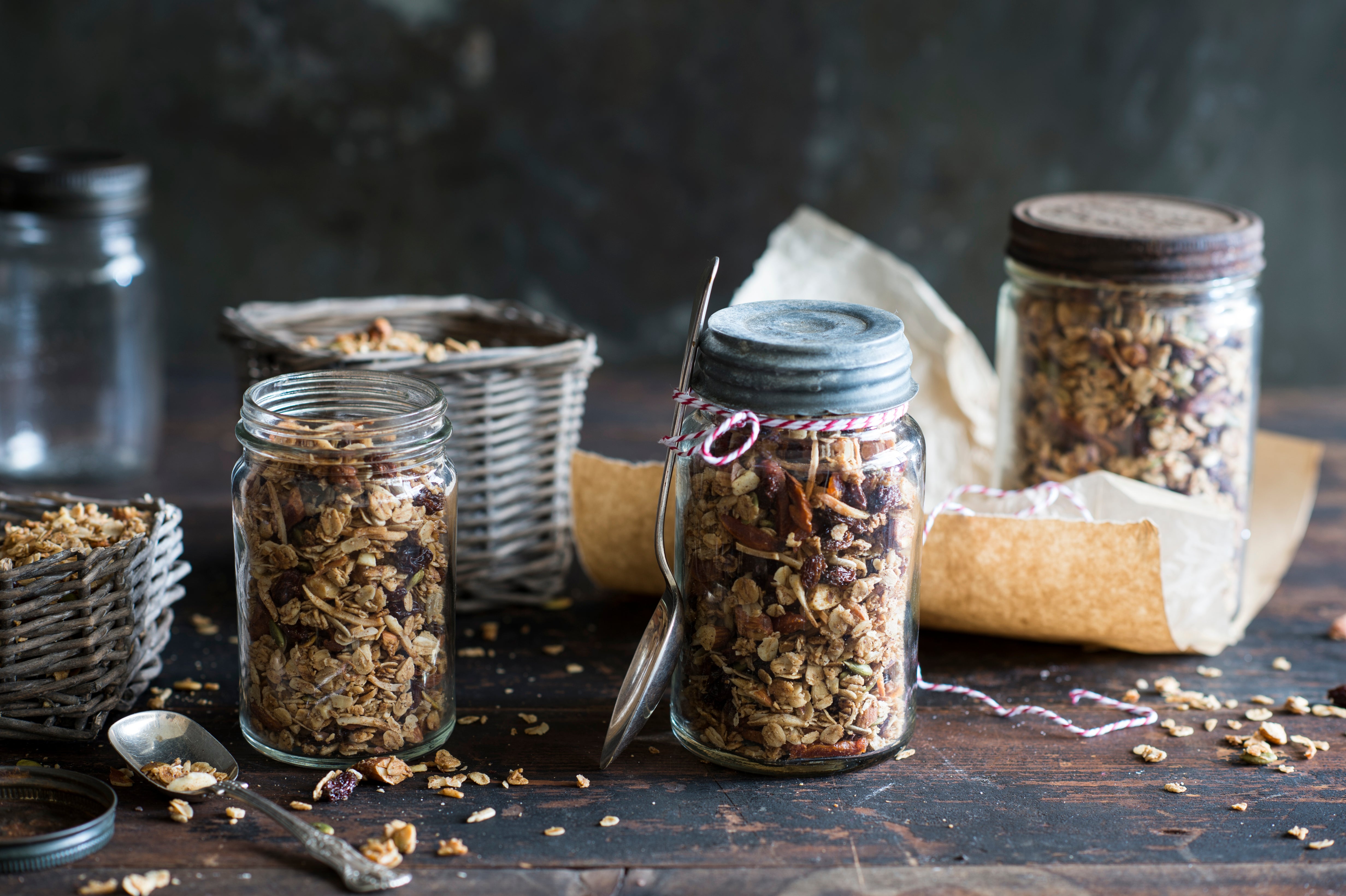
Prep 15min (+30min cooling time)Bake 40minMakes 7 cups
There really is nothing like a homemade cereal. One word of advice though – don’t leave the cardamom out as it gives this granola an elusive and fascinating flavour.
Ingredients
285g (3 cups) rolled oats
150g natural almonds, coarsely chopped
55g (¾ cup) shredded coconut
40g (¼ cup) sunflower seeds
40g (¼ cup) pepitas (pumpkin seeds)
2 teaspoons ground cinnamon
½ teaspoon ground cardamom
185ml (¾ cup) maple syrup
2 tablespoons sunflower oil
2 teaspoons vanilla essence
170g (1 cup) seedless raisins
80g (½ cup) dried apricots, shredded
Method
- Preheat oven to 160°C (140°C fan-forced).
- Line a large baking tray with non-stick baking paper.
- Combine the oats, almonds, coconut, sunflower seeds, pepitas, cinnamon and cardamom in a large heatproof bowl.
- Combine the maple syrup, sunflower oil and vanilla. Add to the oat mixture and use a wooden spoon to mix until evenly combined. Spread over the lined tray and bake in preheated oven for 30 minutes, stirring twice during baking. Stir through the raisins and apricots and bake for a further 10 minutes or until the oats are deep golden and well toasted.
- Cool on the tray (this will take about 30 minutes). Serve with milk, yoghurt and/or fruit.
Baker's Tips
- Store this granola in an airtight container in a cool dark spot for up to 1 month.
This recipe is from Anneka's SBS Food online column, Bakeproof: Gifts from the Kitchen. CLICK HERE for more Bakeproof recipes.
Photography by Alan Benson.
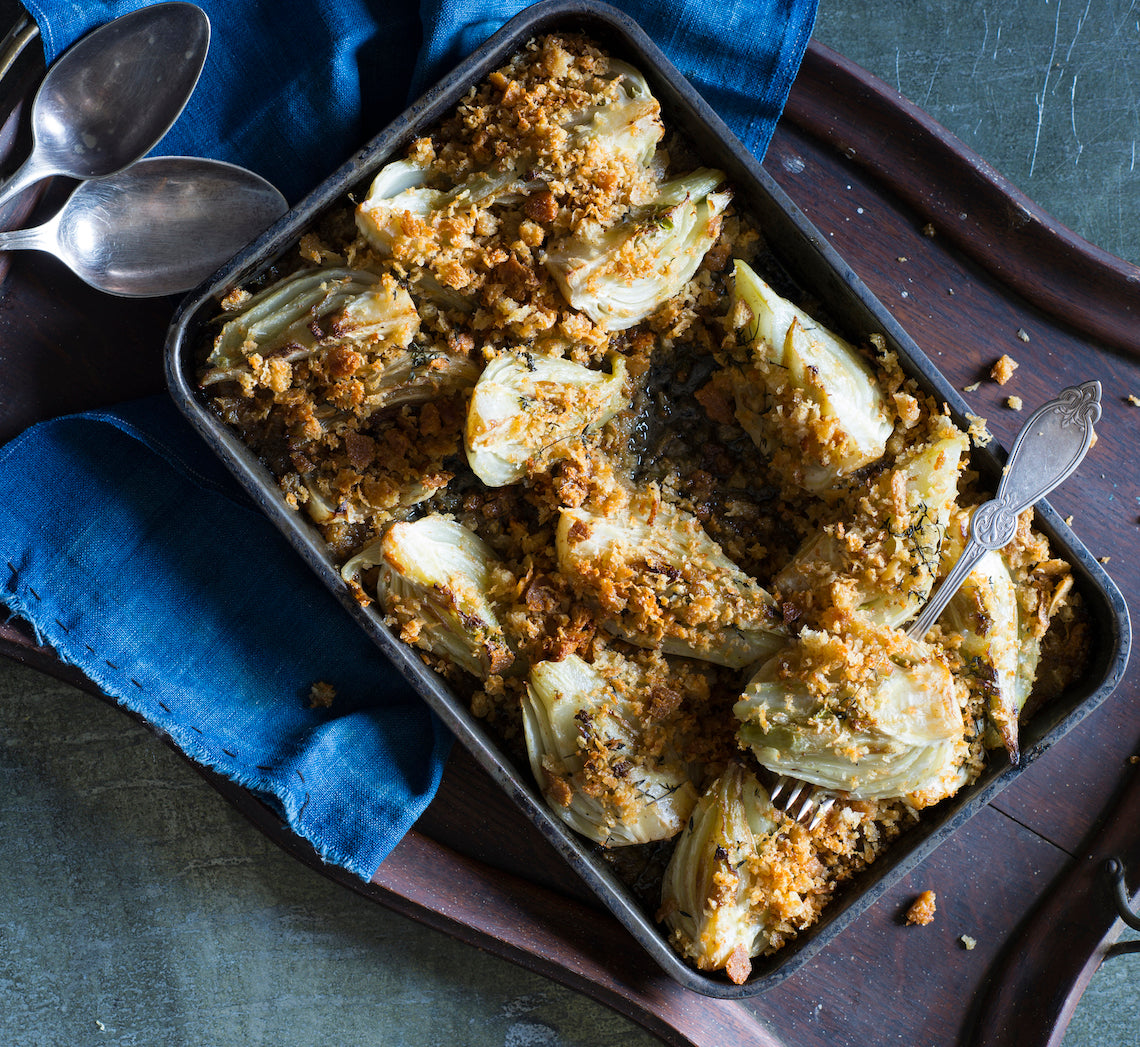
Prep 25minBake 45minMakes 4-6 serves
If you’re not a big fan of fennel then you may just have to reconsider your standing once you have tried this dish. Baked fennel – particularly when teamed with the saltiness of anchovies, the crunch of crisp breadcrumbs and the savouriness of fresh thyme – is one of the best side dishes winter has to offer.
Ingredients
- 2 tablespoons olive oil
5 anchovy fillets, chopped
60g butter
100g coarse sourdough breadcrumbs
2 tablespoons chopped flat-leaf parsley
4 baby fennel bulbs, trimmed, cut into quarters
12 thyme sprigs, leaves picked
250ml (1 cup) good-quality chicken stock
Method
- Preheat the oven to 190°C (180°C fan-forced).
- Heat 1 tablespoon olive oil in a large frying pan over medium heat. Add the anchovies and cook, stirring occasionally, for 2-3 minutes or until the anchovies dissolve. Add 30g of the butter and the breadcrumbs and toss until the breadcrumbs are lightly toasted. Transfer to a bowl, toss through the parsley and set aside.
- Add the remaining oil and butter to the frying pan and heat over medium-high heat until the butter is foaming. Add the fennel in a single layer and cook for 3 minutes each side or until golden and starting to soften.
- Transfer the fennel, in a single layer, to a 2 litre (8 cup) capacity dish, and pour any pan juices over the top. Scatter with the thyme leaves and pour the chicken stock over. Cover with foil and bake for 15 minutes. Remove the foil, sprinkle with the breadcrumbs and bake for a further 20-25 minutes or until the fennel is tender when pierced with a skewer and the breadcrumbs are golden and crisp.
- Serve immediately.
Baker's Tips
- This dish is best eaten straight from the oven, while the fennel is warm and the bread chunks still crisp, however it will keep in an airtight container in the fridge for up to 3 days. Serve at room temperature or reheat at 180°C (160°C fan-forced) for 10 minutes or until heated through.
This recipe is from Anneka's SBS Food online column, Bakeproof: Winter Root Vegetables. CLICK HERE for more Bakeproof recipes.
Photography by Alan Benson.
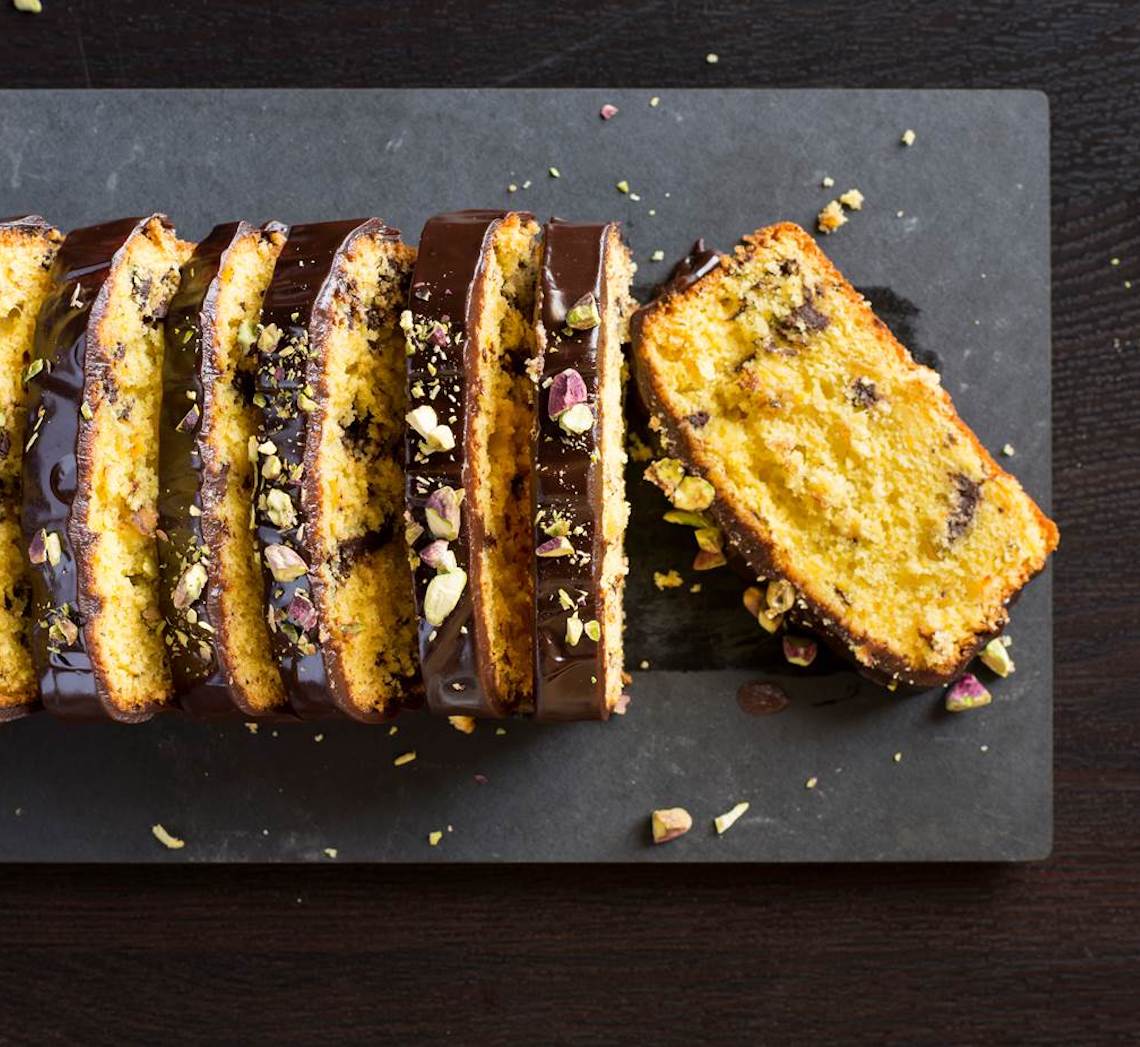
Prep 25min (+ 1hr chilling, 2hr cooling and 30min standing time)Bake 1hrMakes 10 serves
Choc-orange, or jaffa, is such a great flavour. This dead-easy cake is made completely in the food processor using a whole orange, rind and all (no that isn’t a mistake!). Orange flower water is optional in this recipe but will give the cake a slightly more ‘refined’ orange character.
Ingredients
1 orange, quartered, core and seeds removed
220g (1 cup) caster sugar
125g butter, melted and cooled
2 eggs, at room temperature
1 tabsepoon orange flower water, or to taste (optional)
185g (1¼ cups) self-raising flour
35g (¼ cup) plain flour
100g good-quality dark chocolate (54% cocoa), chopped
35g (¼ cup) coarsely chopped toasted pistachios, to sprinkle
Chocolate glaze
150g good-quality dark chocolate (54% cocoa), chopped
125ml (½ cup) pouring cream
Method
- Preheat oven to 170ºC (150ºC fan-forced). Grease 11cm x 21cm (base measurement) loaf tin with melted butter and line the base and two long sides with non-stick baking paper.
- Place the whole orange, sugar, butter, eggs and orange flower water in the bowl of a food processor. Process until the orange is finely chopped. Add the self-raising and plain flours and process until just combined. Transfer the mixture to a bowl and use a large metal spoon or spatula to fold in the chocolate.
- Pour the mixture into the prepared tin and use the back of a spoon to smooth the surface. Bake in preheated oven for 60 minutes or until a skewer inserted into the centre comes out clean. Remove from the oven and set aside for 5 minutes before transferring onto a wire rack to cool (this will take about 2 hours). Place the cake, still on the wire rack in the fridge for 1 hour to chill (this will help the glaze set).
- Meanwhile, to make the chocolate glaze, place the chocolate in a heatproof bowl. Heat the cream in a small saucepan over medium heat until almost simmering. Pour over the chocolate and stand for 1 minute. Stir until melted and smooth. Set aside to until cooled to room temperature. Pour the glaze over the cake on the wire rack, allowing it to drizzle down the sides. Sprinkle with the pistachios and set aside for 30 minutes or until the glaze sets. Serve in slices.
Baker's Tips
- This cake will keep in an airtight container at room temperature for up to 3 days.
This recipe is from Anneka's SBS Food online column, Bakeproof: Easy Chocolate Cakes. CLICK HERE for more Bakeproof recipes.
Photography by Alan Benson.
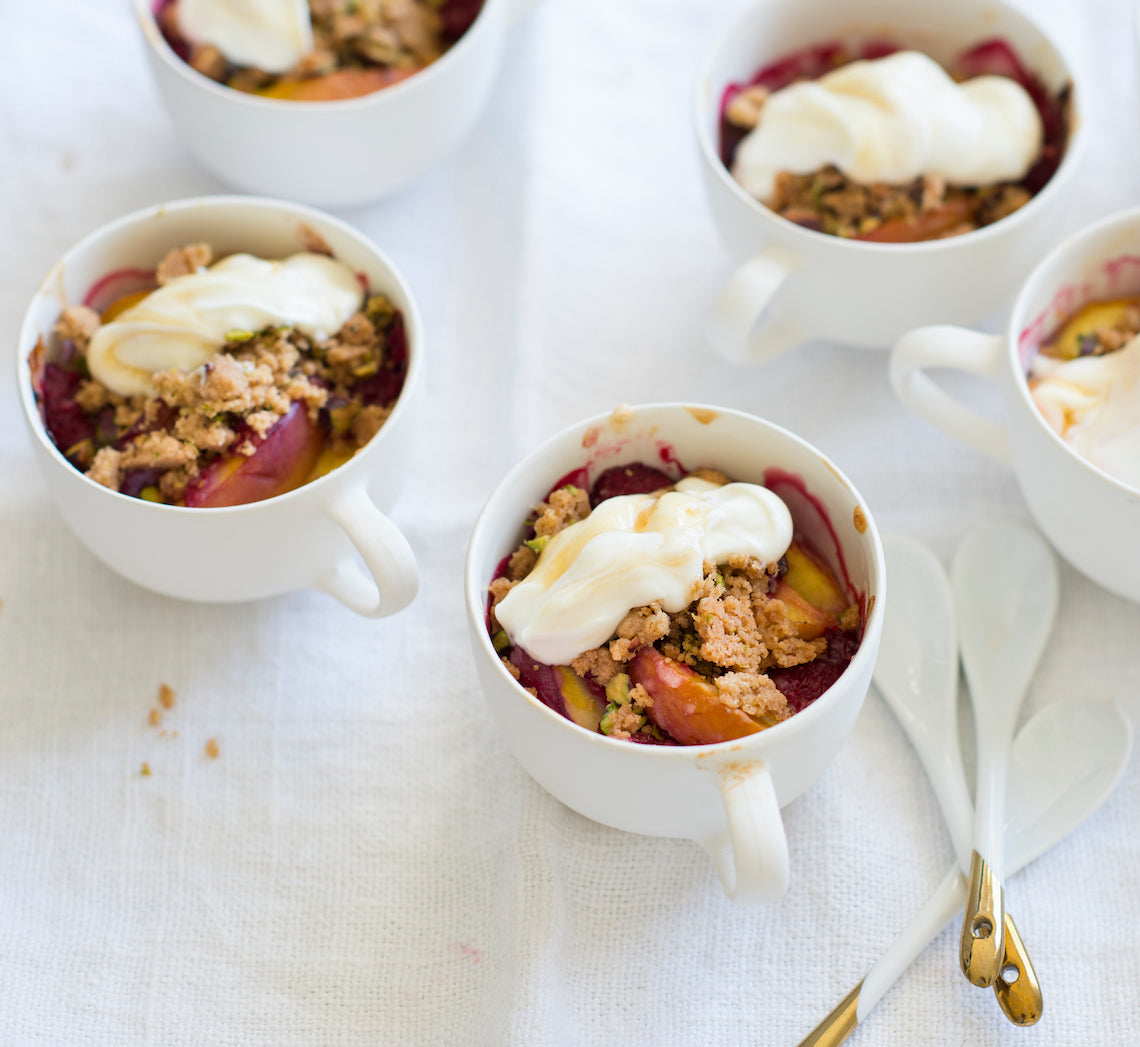
Prep 25minBake 40minMakes 6 serves
We often think of crisps and crumbles as winter desserts, but please don’t pigeon-hole them! This combination of sweet nectarines and tart raspberries, subtly flavoured with rosewater, topped with a pistachio 'crisp' topping and served with honey-flavoured yoghurt is a sublime summer dessert. Any leftovers are good for breakfast!
Ingredients
750g white or yellow nectarines
300g fresh or frozen raspberries or blueberries
55g (¼ cup) caster sugar
3 teaspoons rosewater, or to taste
1½ tablespoons plain flour
Pistachio topping
75g (½ cup) plain flour
55g (¼ cup) caster sugar
1 teaspoon ground cinnamon
80g chilled butter, diced
50g pistachio kernels, chopped, toasted
Honey yoghurt
200g tub Greek-style yoghurt
1 tablespoon pure honey, or to taste
Method
- Preheat oven to 190°C (170°C fan-forced).
- To make the Pistachio topping, combine the flour, sugar and cinnamon in a medium bowl. Use your fingertips to rub in the butter until the mixture begins to resemble coarse breadcrumbs. Stir in the pistachios.
- Halve the nectarines and remove the stones. Cut each half into 4 wedges. Combine with the sugar, rosewater and flour and toss to combine. Add the raspberries and toss gently to combine evenly. Divide the fruit mixture evenly among 6 x 250 ml (1 cup) ramekins or ovenproof dishes. Sprinkle the pistachio crisp topping over the fruit to cover.
- Bake in preheated oven for 35-40 minutes or until the fruit is tender when pierced with a skewer and the topping is crisp and golden.
- Meanwhile, to make the Honey yoghurt, stir the yoghurt and honey in a medium bowl until combined. Cover and refrigerate until required.
- Serve the crisp warm or at room temperature with the honey yoghurt.
Baker's Tips
- You can also bake this crisp in a 1.5 litre (6 cup) ovenproof dish. Bake for 50 minutes.
This recipe is from Anneka's SBS Food online column, Bakeproof: Stone Fruit.
CLICK HERE for more Bakeproof recipes.
Photography by Alan Benson.
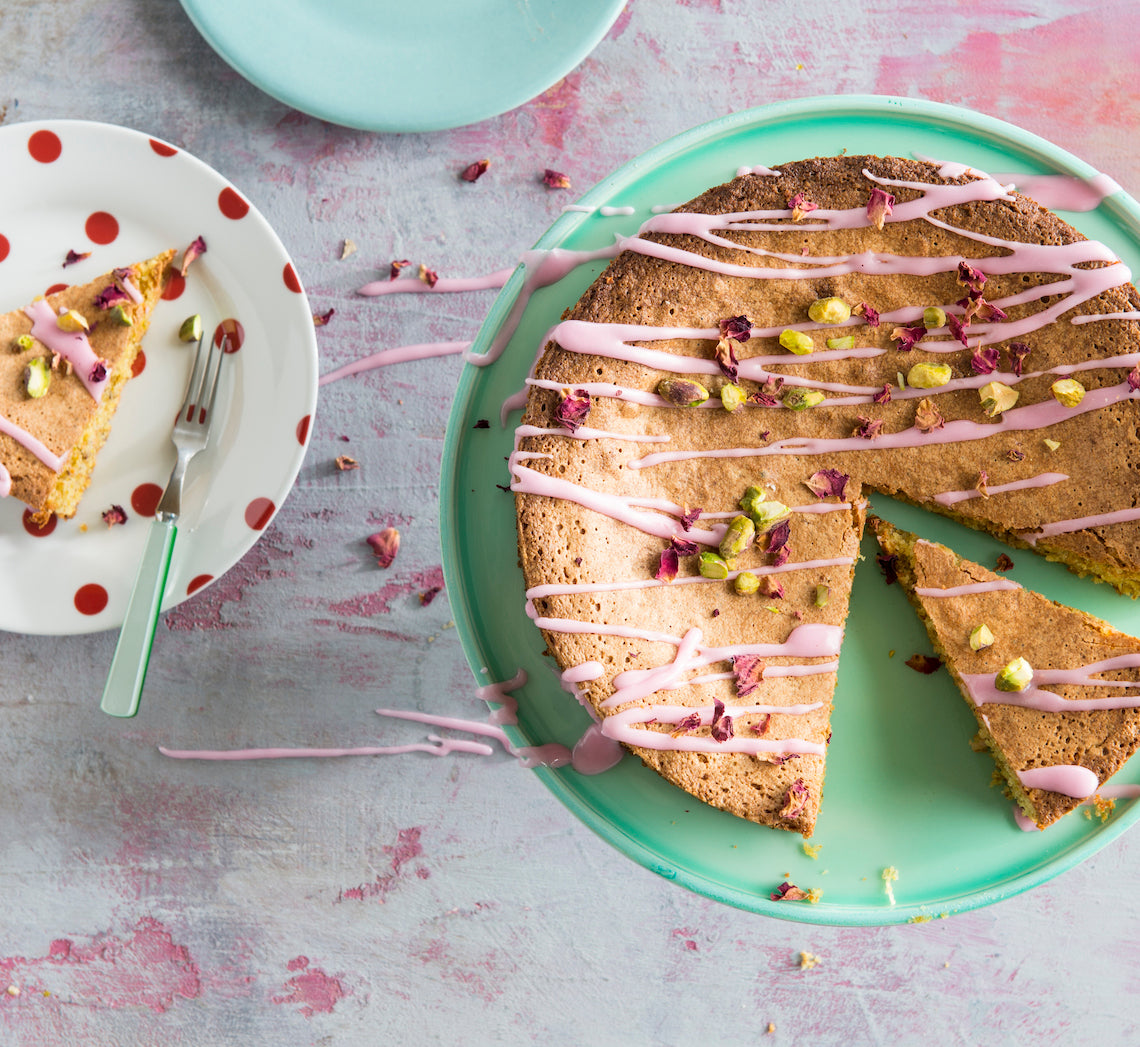
Prep 30min (+1hr cooling time)Bake 30minMakes 8-10 serves
This gluten-free and dairy-free recipe, with its subtle lemon flavour teamed with an aromatic rosewater icing and light nutty texture, is the perfect afternoon-tea cake. It will dip slightly in the centre due to its delicate nature but this is just a sign of how lovely and light it is.
Ingredients
Light olive oil, to grease
100g (1 cup) almond meal
100g (¾ cup) raw unsalted pistachios, toasted and finely ground
90g (½ cup) instant polenta or wholegrain corn flour
2 teaspoons gluten-free baking powder
3 eggs, at room temperature
165g (¾ cup) caster sugar
125ml (½ cup) light olive oil
1 lemon, rind finely shredded, juiced
extra raw unsalted pistachios, toasted and coarsely chopped, to decorate
dried rose petals (optional), to decorate
Lemon and rosewater icing
125g (1 cup) pure icing sugar
1 tablespoon (about) strained fresh lemon juice
1 teaspoon rosewater
gluten-free pink or rose food colouring, to tint
Method
- Preheat oven to 180°C (160°C fan-forced). Brush a 20cm springform cake tin with olive oil and line the base with non-stick baking paper.
- Place the almond meal, ground pistachios, polenta and baking powder in a medium bowl and use a whisk to stir to combine and remove any lumps. Set aside.
- Use an electric mixer with a whisk attachment to whisk the eggs and sugar on medium-high speed until thick and pale and a ribbon trail forms when the whisk is lifted. Whisk in the olive oil, 2 tablespoons of the lemon juice and the lemon rind.
- Add the dry ingredients to the egg mixture and use a spatula or large metal spoon to fold until evenly combined. Pour into the prepared cake tin and bake for 30 minutes or until a skewer inserted in the centre comes out clean. Stand the cake in the tin on a wire rack for 10 minutes before removing the sides of the tin. Set aside to cool completely.
- To make the lemon and rosewater icing, sift the icing sugar into a medium bowl. Gradually stir in the 1 tablespoon lemon juice and the rosewater until the mixture is smooth and has a thick coating consistency, adding a little more juice if needed. Cover with plastic wrap and set aside at room temperature until ready to use.
- Drizzle the cooled cake with the icing and then sprinkle with extra pistachio nuts and dried rose petals, if using. Set aside for 30 minutes or until the icing has set before serving in wedges.
Baker's Tips
- This cake will keep in an airtight container at room temperature for up to 4 days.
This recipe is from Anneka's SBS Food online column Bakeproof: Gluten-free baking. Click here for more Bakeproof columns and recipes.
Photography by Alan Benson.
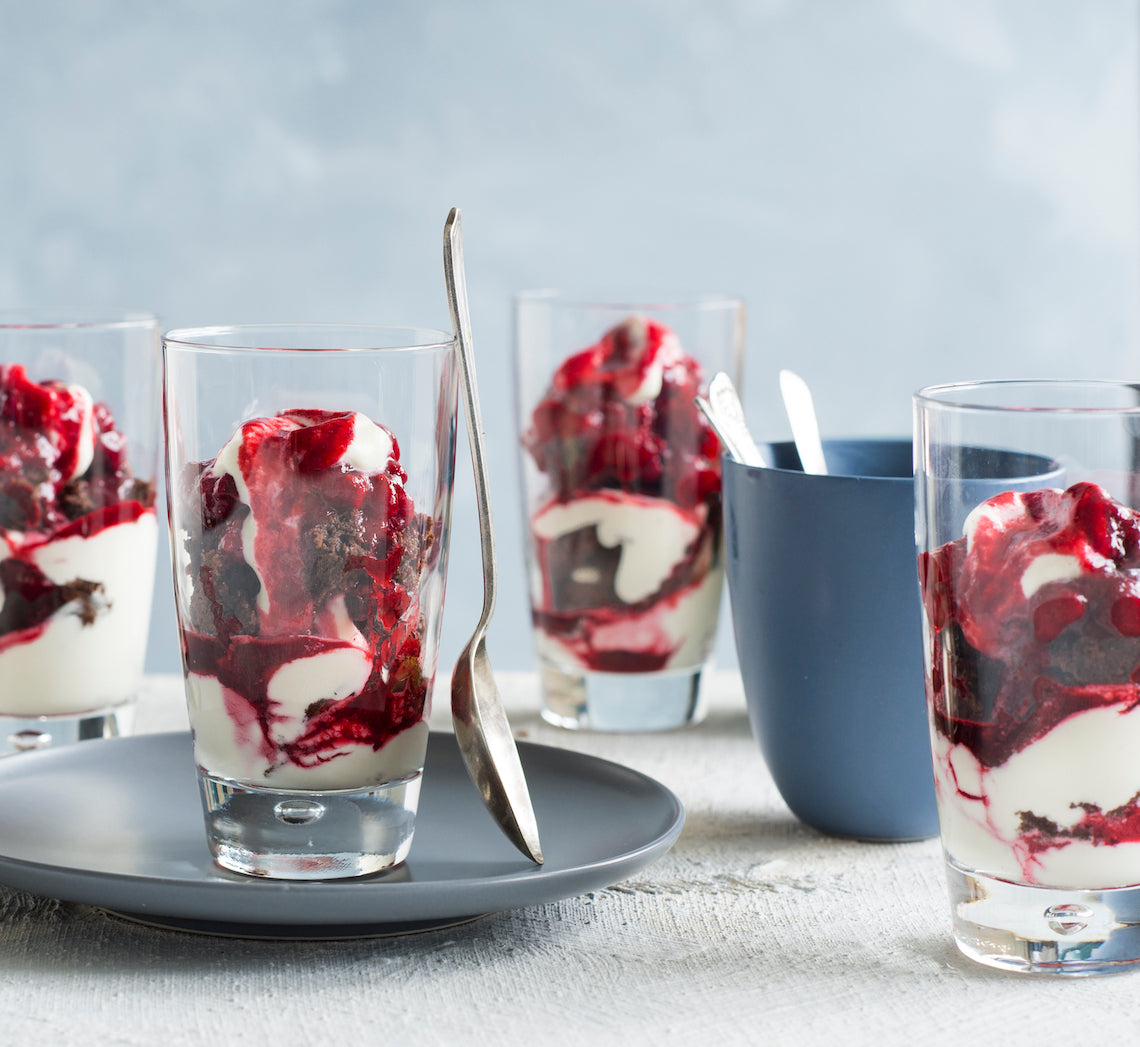
Prep 40min (+2hr cooling, 30min standing and 2hr chilling time)
Bake 45minMakes 10 serves
These trifles are a complete contradiction in terms when it comes to eating them – they are rich yet refreshing, sweet yet tart, indulgent yet light – and that’s what makes them so good.
Ingredients
Brownie cake
200g good-quality dark chocolate (45-54% cocoa solids), chopped
185g butter, cubed
220g (1 cup) caster sugar
3 eggs, at room temperature, lightly whisked
1 teaspoon natural vanilla extract or essence
185g (1¼ cups) plain flour
30g (¼ cup) Dutch cocoa powder
¾ teaspoon baking powder
Minted custard cream
375ml (1½ cups) milk
8 sprigs fresh mint
3 egg yolks
2 tablespoons caster sugar
1 teaspoon natural vanilla essence or extract
500ml (2 cups) thickened cream, whipped to soft peaks
Sweetened raspberries
600g frozen raspberries
55g (¼ cup) caster sugar
1½ tablespoons lemon juice
Method
- To make the Minted Custard Cream, put the milk and mint sprigs into a medium saucepan. Bring just to a simmer over a medium heat. Remove from heat and stand for 30 minutes to infuse. Remove the mint sprigs. Use a balloon whisk to whisk the egg yolks and sugar together in a heatproof bowl. Gradually whisk in the milk mixture until smooth and well combined. Return to the heat and stir constantly with the whisk over medium heat until the mixture thickens enough to coat the back of a spoon (do not simmer). Remove from the heat and stir in the vanilla. Pass the custard through a sieve into a heatproof bowl. Cover the surface with plastic wrap and refrigerate for 2 hours or until chilled.
- To make the Brownie Cake, preheat oven to 160°C (140°C fan-forced). Grease a 20cm springform tin with melted butter and line the base with piece of non-stick baking paper. Place the chocolate and butter in a medium heatproof bowl over a saucepan of simmering water (don’t let the base of the bowl touch the water). Stir occasionally until chocolate and butter melt and the mixture is smooth. Remove bowl from saucepan and set aside to cool slightly. Use an electric mixer with a whisk attachment to whisk the sugar, eggs and vanilla until thick and pale and a ribbon trail forms when the whisk is lifted. Whisk in the melted chocolate mixture. Sift together the flour, cocoa and baking powder, add to the egg mixture and use a large metal spoon or spatula to fold in until just combined.
- Pour mixture into the prepared tin and spread evenly. Bake for 40-45 minutes or until moist crumbs cling to a skewer inserted in the centre. Remove from the oven and cool in tin on a wire rack (this will take about 2 hours). Use a large serrated knife to cut the cake in half horizontally and then break it into chunks.
- To make the Sweetened Raspberries, combine the frozen raspberries, sugar and lemon juice in a medium saucepan. Cover and cook over medium heat, stirring occasionally until the raspberries have just thawed. Remove from heat and set aside to cool.
- To finish the Minted Custard Cream, fold the whipped cream through the chilled custard.
- To assemble, layer the Custard Cream, Brownie Cake chunks, and Sweetened Raspberries and their juice in individual glasses.
Baker's Tips
- The Brownie Cake will keep in an airtight continer at room temperature for up to 4 days. The Minted Custard Cream and Sweetned Raspberries will keep in separate airtight containers in the fridge for up to 2 days.
- You can also layer this trifle on one large serving dish and serve in scoops.
Photography by Alan Benson.
This recipe is from Anneka's SBS Food online column, Bakeproof: Brownies.
CLICK HERE for more Bakeproof columns and recipes.






